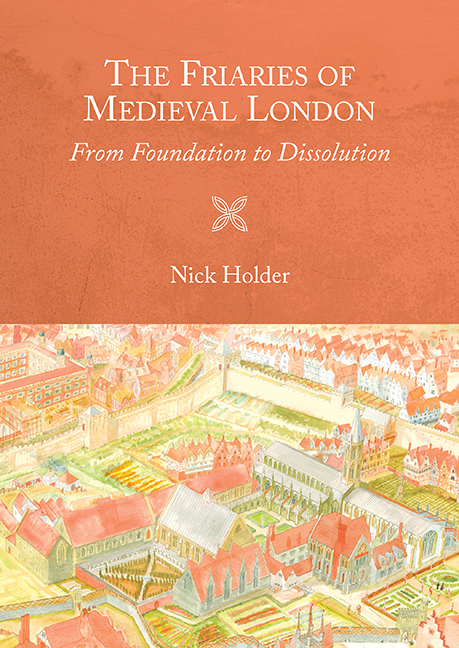Book contents
- Frontmatter
- Contents
- List of Illustrations and Tables
- Contributors
- Acknowledgements
- Abbreviations
- Introduction
- Part I The Nine London Friaries
- Part II The London Friars and their Friaries
- 10 Churches
- 11 Precincts and the Use of Space
- 12 Architecture and Architectural Fragments of the London Friaries
- 13 Floor Tiles and Building Materials from the London Friaries
- 14 Water Supply
- 15 Economy
- 16 Spiritual Life and Education in the London Friaries
- 17 Burial and Commemoration in the London Friaries
- 18 London Friars and Londoners
- 19 Dissolution
- Conclusions
- Timeline
- Bibliography
- Index
- Miscellaneous Endmatter
13 - Floor Tiles and Building Materials from the London Friaries
from Part II - The London Friars and their Friaries
Published online by Cambridge University Press: 16 May 2018
- Frontmatter
- Contents
- List of Illustrations and Tables
- Contributors
- Acknowledgements
- Abbreviations
- Introduction
- Part I The Nine London Friaries
- Part II The London Friars and their Friaries
- 10 Churches
- 11 Precincts and the Use of Space
- 12 Architecture and Architectural Fragments of the London Friaries
- 13 Floor Tiles and Building Materials from the London Friaries
- 14 Water Supply
- 15 Economy
- 16 Spiritual Life and Education in the London Friaries
- 17 Burial and Commemoration in the London Friaries
- 18 London Friars and Londoners
- 19 Dissolution
- Conclusions
- Timeline
- Bibliography
- Index
- Miscellaneous Endmatter
Summary
CONSIDERABLE amounts of building material have been recovered from archaeological excavations on sites within Black Friars, White Friars and Austin Friars. A fair quantity was also recovered from Crossed Friars, although much was roofing tile. There is relatively little building material from Grey Friars, a reflection of the fact that so much of the archaeological evidence of the western part of the friary was destroyed in the early twentieth century (during the construction of the new General Post Office building). This chapter concentrates on the floor tiles from the friaries; other building materials such as roof tiles are dealt with in more summary form. As is the case for most London archaeological sites, these floor tiles were found as building rubble, not as in situ floors. However, Londoners have usually avoided moving their unwanted earth and rubble too far and so the area where a particular tile or group of tiles was found may give a good indication of their likely original setting.
The types of floor tile are therefore tabulated by friary, archaeological site and area of friary in Table 15. The majority of these decorated floor tiles (except for unrecognisable fragments) are illustrated in a series of friary-by-friary figures (Figure 80 to Figure 84). Medieval floor tiles are usually categorised by their place of manufacture (for example, Chertsey), although the name sometimes refers to the location of their first discovery (for example, Westminster). The types of tile found in the London friaries are listed in Table 16. The tile designs are referred to by typological codes (for example, ‘Westminster’ tile W3 on Figure 80). These codes relate to classification systems developed for each tile type. The bibliographic references for these codes are given in Table 16. Some tile designs found at the friaries have never before been published; these are labelled T1, T2 (etc) on Figure 80 to Figure 84. The numerical fabric codes for the ceramic building material discussed in this chapter (for example, Low Countries tile fabric 2320; below, ‘Black Friars’) refer to a fabric reference collection held by Museum of London Archaeology, which can be consulted on request. Building stone types are discussed in this chapter; architectural fragments are discussed in Chapter 12: Architecture and Architectural Fragments of the London Friaries.
- Type
- Chapter
- Information
- The Friaries of Medieval LondonFrom Foundation to Dissolution, pp. 227 - 244Publisher: Boydell & BrewerPrint publication year: 2017
- 1
- Cited by

